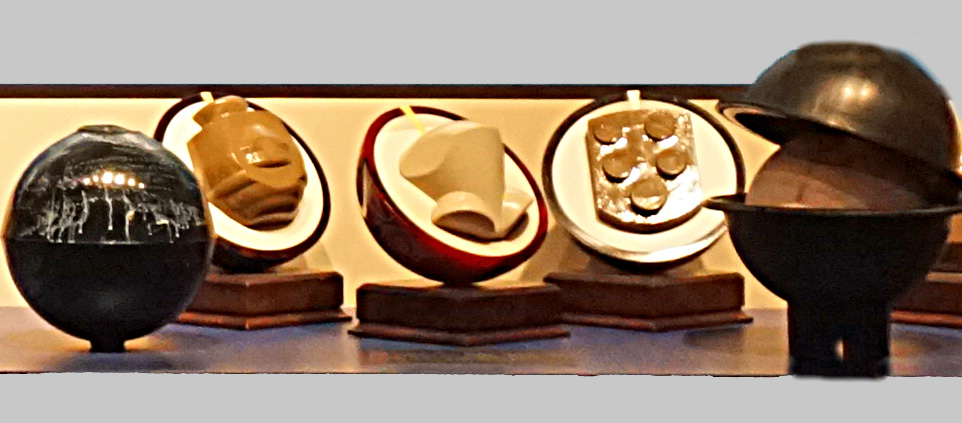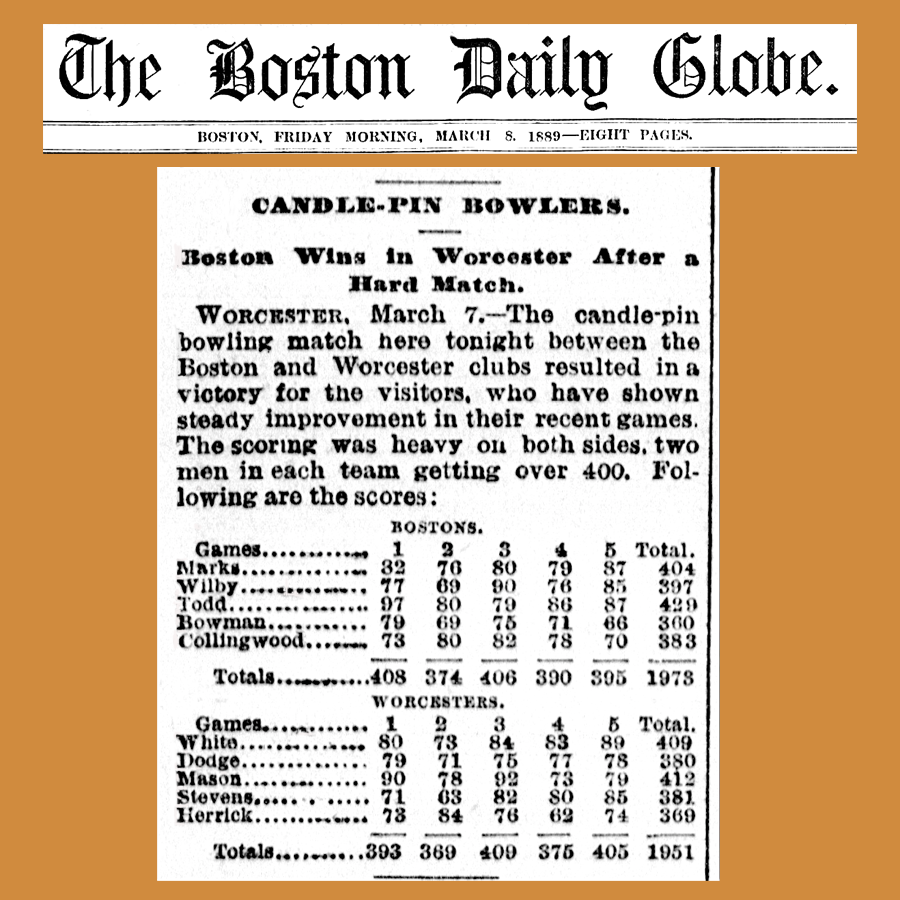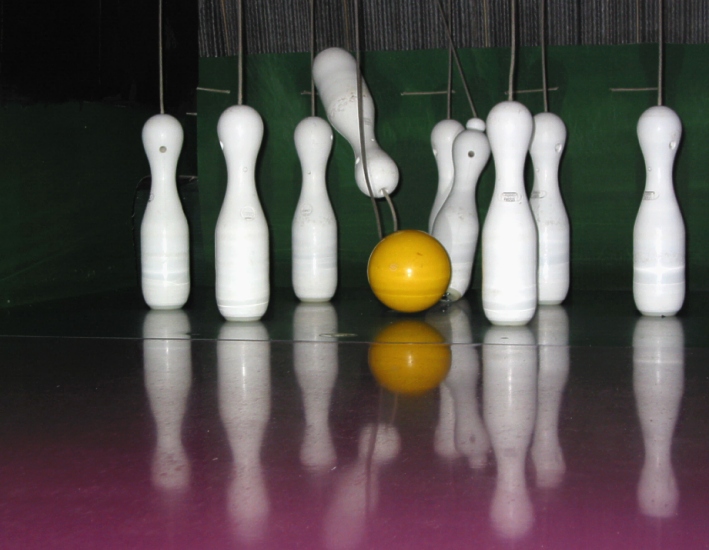|
Bowling
Bowling is a Throwing sports#Target sports, target sport and recreational activity in which a player rolls a bowling ball, ball toward Bowling pin, pins (in pin bowling) or another target (in target bowling). Most references to ''bowling'' are to pin bowling, specifically tenpin bowling, played in the United Kingdom and Commonwealth realm, Commonwealth countries. ''Bowling'' can also refer to target bowling, such as lawn bowls. Bowling is played by 120 million people in more than 90 countries, including 70 million people in the United States alone. In pin bowling, players knock over Bowling pin, pins on a long smooth surface called a ''Bowling alley, lane''. Lanes have a wood or synthetic surface with protective lubricating oil applied in different oil patterns that affect Bowling ball#Ball motion, ball motion. A strike (bowling), strike is achieved when all the pins are knocked down on the first roll, and a spare is achieved if all remaining pins are knocked over on a second ro ... [...More Info...] [...Related Items...] OR: [Wikipedia] [Google] [Baidu] |
Tenpin Bowling
Tenpin bowling is a type of bowling in which a bowler bowling form, rolls a bowling ball down a wood or synthetic lane toward ten pins positioned Tetractys, evenly in four rows in an equilateral triangle. The goal is to knock down all ten Bowling pin, pins on the first roll of the ball (a strike), or failing that, on the second roll (a spare). While most people approach modern tenpin bowling as a simple recreational pastime, those who bowl competitively, especially at the highest levels, consider it a demanding sport requiring precision and skill. An approximately long ''approach'' area used by the bowler to impart speed and apply rotation to the ball ends in a ''foul line''. The , lane is bordered along its length by ''gutters'' (''channels'') that collect errant balls. The lane's long and narrow shape limits straight-line ball paths to angles that are smaller than optimum angles for achieving strikes; accordingly, bowlers impart side rotation to ''hook (bowling), hook'' (curv ... [...More Info...] [...Related Items...] OR: [Wikipedia] [Google] [Baidu] |
Bowling Ball
A bowling ball is a hard spherical ball used to knock down bowling pins in the sport of bowling. Balls used in ten-pin bowling and American nine-pin bowling traditionally have holes for two fingers and the thumb. Balls used in five-pin bowling, candlepin bowling, duckpin bowling, and European nine-pin bowling have no holes, and are small enough to be held in the palm of the hand. Ten-pin balls Specifications The USBC and World Bowling promulgate bowling ball specifications. USBC specifications include physical requirements for weight (≤), diameter (—), surface hardness, surface roughness, hole drilling limitations (example: a single balance hole ''including'' the thumb hole for "two-handed" bowlers), balance, plug limitations, and exterior markings (structural and commercial), as well as requirements for dynamic performance characteristics such as radius of gyration (RG; 2.46—2.80), RG differential (≤0.06), and coefficient of friction (≤0.32). The USBC banned ... [...More Info...] [...Related Items...] OR: [Wikipedia] [Google] [Baidu] |
Candlepin Bowling
Candlepin bowling is a variation of bowling that is played primarily in the Canadian Maritimes, Canadian Maritime provinces and the New England region of the United States. It is played with a handheld-sized bowling ball, ball and tall, narrow bowling pin, pins that resemble candles, hence the name. Comparison to ten-pin bowling As in other forms of pin bowling, players roll balls down a wooden or synthetic lane to knock down as many pins as possible. Differences between candlepin bowling and ten-pin bowling include: * Candlepin involves three rolls per frame, rather than two rolls as in ten-pin. * Candlepin balls are much smaller, being in diameter and have a maximum weight of They are almost identical in weight to a pin, as opposed to ten-pin balls whose maximum allowable weight is more than four times that of a pin. * No oil is applied to the lane, so the ball does not skid but rolls all the way down the lane. * Candlepin balls lack finger holes. * Candlepins are thinner ... [...More Info...] [...Related Items...] OR: [Wikipedia] [Google] [Baidu] |
Candlepin
Candlepin bowling is a variation of bowling that is played primarily in the Canadian Maritime provinces and the New England region of the United States. It is played with a handheld-sized ball and tall, narrow pins that resemble candles, hence the name. Comparison to ten-pin bowling As in other forms of pin bowling, players roll balls down a wooden or synthetic lane to knock down as many pins as possible. Differences between candlepin bowling and ten-pin bowling include: * Candlepin involves three rolls per frame, rather than two rolls as in ten-pin. * Candlepin balls are much smaller, being in diameter and have a maximum weight of They are almost identical in weight to a pin, as opposed to ten-pin balls whose maximum allowable weight is more than four times that of a pin. * No oil is applied to the lane, so the ball does not skid but rolls all the way down the lane. * Candlepin balls lack finger holes. * Candlepins are thinner (hence the name "candlepin"), which increases ... [...More Info...] [...Related Items...] OR: [Wikipedia] [Google] [Baidu] |
Five-pin Bowling
Five-pin bowling is a bowling variant which is played in Canada, where many bowling alleys offer it, either alone or in combination with ten-pin bowling. It was devised around 1909 by Thomas F. Ryan in Toronto, Ontario, at his Toronto Bowling Club, in response to customers who complained that the ten-pin game was too strenuous. He cut five tenpins down to about 75% of their size, and used hand-sized hard rubber balls, thus inventing the original version of five-pin bowling. Gameplay The balls in five pin bowling are small enough to fit in the hand and therefore typically have no fingerholes, although the Canadian 5 Pin Bowlers Association (C5PBA) has approved balls with thumb holes. At the end of the lane there are five pins arranged in a V. They are midway in size between duckpins and ten pins, and they have a heavy rubber band around their middles to make them move farther when struck. Unlike any other form of bowling popular in North America, the pins in five-pin bowling ... [...More Info...] [...Related Items...] OR: [Wikipedia] [Google] [Baidu] |
Duckpin Bowling
Duckpin bowling is a variation of the sport of bowling. Duckpin balls are in diameter, weigh between each, and lack finger holes. They are thus significantly smaller than those used in ten-pin bowling but are slightly larger and heavier than those used in candlepin bowling. Duckpins, although arranged in a triangle identical to that used in ten-pin bowling, are shorter, slightly thinner, and lighter than their ten-pin equivalents, which makes it more difficult for the smaller ball to achieve a Strike (bowling), strike. For this reason, similar to candlepin bowling, the bowler is allowed three rolls per frame. Rules Duckpin bowling has rules similar to ten-pin bowling. In a 10-frame game, bowlers try to knock down pins in the fewest rolls per frame. Bowlers have three balls per frame, instead of two as in ten-pin bowling, to knock over a set of 10 pins. If a bowler knocks down all 10 pins with their first roll in a frame, it is scored as a ''Strike (bowling), strike''. If al ... [...More Info...] [...Related Items...] OR: [Wikipedia] [Google] [Baidu] |
Bowling Pin
Bowling pins (historically also known as skittles or kegels) are upright elongated solids of rotation with a flat base for setting, usually made of wood (esp. maple) standing between 9 and 16 inches (23 and 41cm) tall. Some have interior voids to adjust weight and balance. Pins are coated with plastic and painted, by convention mostly white with (usually) transaxial red stripes or other markings around the neck or middle (candlepins). Sets of pins, usually 5, 9, or 10 in a triangular arrangement, are the target of the bowling ball in various bowling games including tenpins, five-pins, duckpins and candlepins. Tenpins Pin specifications are set by the United States Bowling Congress (USBC). World Bowling, formerly World Tenpin Bowling Association, has adopted the USBC specifications. Pins are tall, wide at their widest point, and weigh ±. The first British made tenpin was by H Massil and sons who received the permit no.1 from the British Tenpin Bowling Association (BTBA ... [...More Info...] [...Related Items...] OR: [Wikipedia] [Google] [Baidu] |
Bowling Alley
A bowling alley (also known as a bowling center, bowling lounge, bowling arena, or historically bowling club) is a facility where the sport of bowling is played. It can be a dedicated facility or part of another, such as a clubhouse or dwelling house. History By the late 1830s in New York City, the Knickerbocker Hotel's bowling alley had opened, with three lanes. Instead of wood, this indoor alley used clay for the bowling lane. By 1850, there were more than 400 bowling alleys in New York City, which earned it the title "bowling capital of North America". Because early versions of bowling were difficult and there were concerns about gambling, the sport faltered. Several cities in the United States regulated bowling due to its association with gambling. In the late 19th century, bowling was revived in many U.S. cities. Alleys were often located in saloon basements and provided a place for working-class men to meet, socialize, and drink alcohol. Bars were and still are a principa ... [...More Info...] [...Related Items...] OR: [Wikipedia] [Google] [Baidu] |






